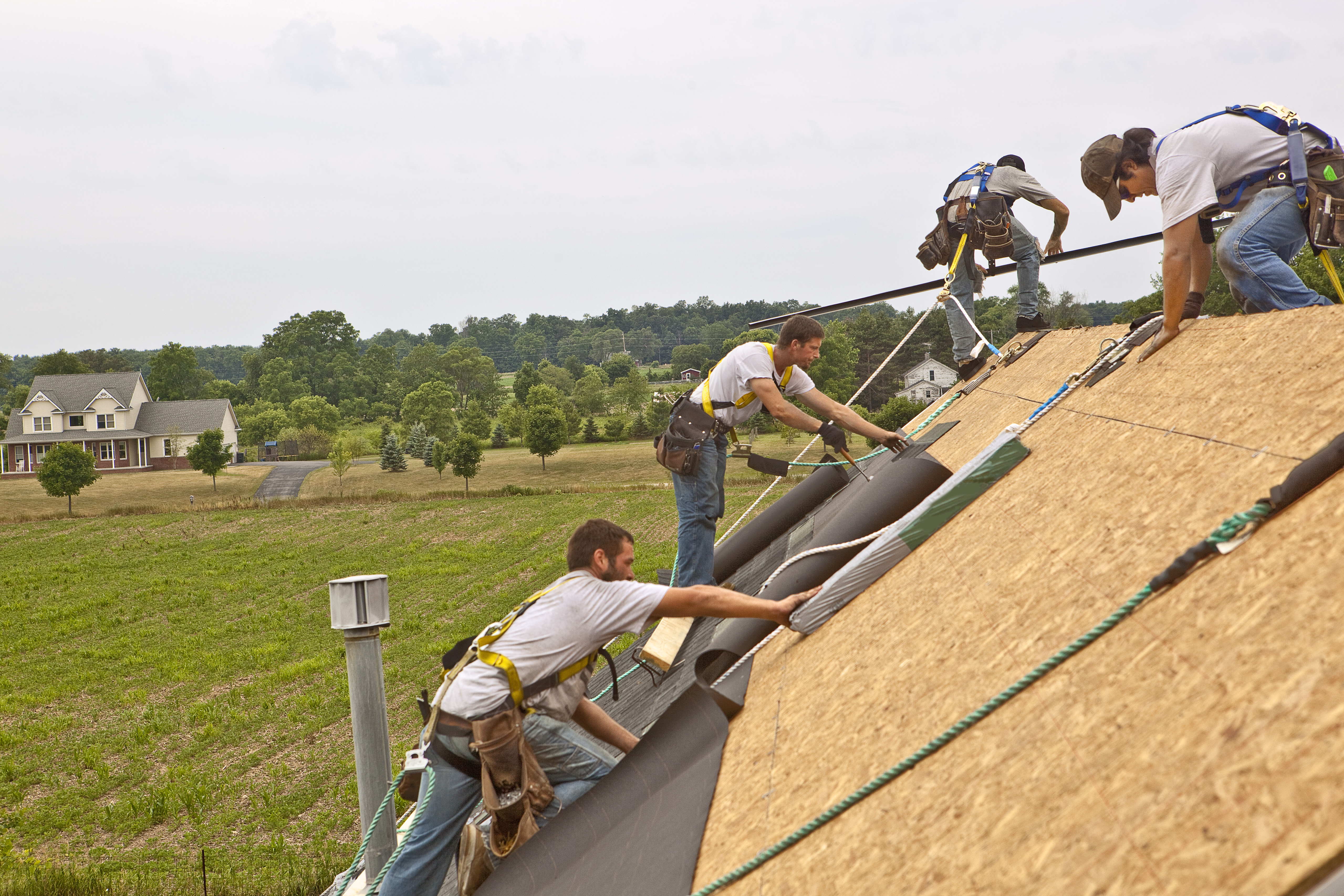How long does a roof last – and the signs that yours needs replacing
Asking how long does a roof last? We have the inside track of roof life expectancy


How long does a roof last? It’s an important question because a sound roof is fundamental to the integrity of your home and, if a roof isn’t replaced when necessary, you could open yourself up to lots of other expense on top of paying for a new one.
The lifespan of your roof will be influenced by what it’s made from, what the conditions are like where you live, and how well it was installed in the first place, but we’ve got the lowdown on all the different types as well as the factors that could reduce its life. We’ll tell you how to assess whether the time has come to replace it, too.
Just scroll down for the answers to all your roof life expectancy questions, and for all you need to know about house renovation, check out our expert guide.
How often does a roof need to be replaced?
Let’s start with the good news. Roofs in general have a good long lifespan. The other side of the coin, of course, is that the roof of your home may already have been in place for many years.
The life expectancy of a roof varies according to the material from which it is made so here’s what you need to know for each type.
How long do asphalt shingles last?
In the US, asphalt shingles are the most common roof material. They’re expected to last somewhere between 15 and 25 years, but bear in mind that there are different types of asphalt shingles.
The cheapest three tab asphalt shingles are likely to have a lifespan of around 15 to 20 years. More expensive are architectural or dimensional shingles, but they could last up to around 25 years and can withstand more testing weather conditions. The most expensive premium versions could last up to 30 years and tolerate the highest maximum wind uplift.
Get small space home decor ideas, celeb inspiration, DIY tips and more, straight to your inbox!
How long do wood shakes and shingles last?
The life expectancy of a roof made from wood can be up to 30 or 40 years, depending on the type of wood. It’s often cedar that’s used because it is resistant to both rot and insects.
Regular maintenance of a wood roof is required for it to achieve the longest possible lifespan, including cleaning and staining.
- Keep reading: 38 DIY home repairs - Quick fixes anyone can do
How long do clay and concrete roof tiles last?
Clay roof tiles can offer a long lifespan of between 50 and 100 years, while concrete – which costs less – can offer a life expectancy of 40 to 75 years, so they’re both highly durable.
How long do slate roof tiles last?
Slate tiles are another roofing material with a long life expectancy. We‘re talking periods of around 50 to 100 years.
- Keep reading: Attic ventilation - A complete guide to ventilation options, costs, and installation
How long does a metal roof last?
The life expectancy of a metal roof will vary according to the type of metal used. Copper or zinc roofing as well as other premium metals can last for more than 50 years and even 100, and while costly to fit will therefore repay the investment.
The cheapest metal roof is made from ribbed panels, and with one of these a lifespan of between 25 and 40 years should be anticipated. Standing seam metal roofing might last 50 years.
Also available are stone-coated metal tiles, which are often chosen in areas subject to hurricanes. They can last from 30 to 50 years.
How long does a thatched roof last?
The life expectancy of a thatched roof varies according to the thatching material, ranging from 15 to more than 40 years. However, bear in mind that the ridge of a thatched roof needs replacement every 10 years or so.
How do I know if my roof needs to be replaced?
You’ll need to replace a roof following a catastrophic event such as a house fire, hurricane or tornado, but even aside from disasters such as these, a roof will need replacing in time.
Signs that a roof with asphalt shingles may need replacing include seeing those that are cracked, buckled or curling. They may also be losing granules, which you might see in gutters.
Wood shakes and shingles may split or rot, show damage or have growth of mold or algae.
If you have a roof with clay tiles, look out for those that are cracked or chipped. You might spot leaks in the attic, too.
Look out for missing shingles from a slate roof along with cracks, and check the attic for water stains.
If yours is a metal roof, problems can reveal themselves in the attic or you could observe discoloration or rust.
On a thatched roof look out for raised netting and obvious fixings on the ridge, plus ridges and dips on the roof, as well as growth of moss and lichen.
Check your roof regularly and call in a professional for advice on whether repairs are sufficient or replacement is due.
How long do roofs last in the US vs the UK?
Roofs may have a shorter lifespan in the US versus the UK. The main materials employed for roofing in the UK are slate, clay and concrete tiles which are materials with longer life expectancies than the asphalt shingles most often used in the US.
Another factor that influences how long a roof lasts is the environmental conditions in a particular region: high winds, extreme temperatures, and major weather events can all affect the lifespan of a roof. Intense heatwaves, and major hurricanes and snowstorms are not events the UK is known for and thus roofs don’t have their lifespans decreased by these occurrences.
To obtain the longest life from your roof in the US consider the different roofing materials in relation to the climate. ‘If you live in the more humid parts of the USA, such as Florida or Louisiana, I’d recommend opting for reflective metal or terracotta as your roofing material,’ says Volodymyr Barabakh, Co-founder & Project Director of BM International Builders. ‘These both protect the wooden framing of the roof from heat damage, and offer resistance to damp.’
Phillip Ash, founder of Pro Paint Corner advises, ‘Extremely hot temperatures like Arizona will cause asphalt shingles to crack quite quickly, but asphalt does great in colder climates. Wood is also a good choice for colder climates because it provides twice the insulation than asphalt , but if you live somewhere very wet, like Washington state, you want to avoid using wood roof tiles. Wood is very porous and will absorb moisture leading to mold and algae growth.
‘If you live in a state often hit with hurricanes you may want to consider a stone coated steel tile because of its ability to withstand high wind speeds.’
Roof maintenance pro tips
Use these tips from the professionals to keep your roof in good shape for longer.
‘A pro tip for making your roof last longer is to be sure and cut all limbs from surrounding trees that are physically touching your roof,’ says Rick Abbiati, owner of Colony Property Investments. ‘Even the smallest limb touching your roof can rub a hole right through the shingles and thus cause a water leak. With every gust of wind that branch is working its way through the shingles. Extend the life of your roof by keeping all fauna cut back.’
‘The most common thing that grows on tile roofs is algae,’ says Mark Soto, professional roofer with Roofing MKE. ‘You will want to continuously clean this from roofs with a combination of water and bleach. While some people use pressure washers, this is not recommended since it can actually damage the tiles. Cleaning them with your solution and then watering it down with a hose is the best way to go about it. Since tiles aren’t great at dealing with people walking on them, try to do it from the edge while on a ladder.’
‘If you live in the snowiest cities of the country, including Rochester, Erie, Buffalo, Cleveland, Grand Rapids, Portland, Albany, and around them, it’s recommended to build a house roof considering heavy snowfalls,’ says Sean Chapman, professional carpenter and founder of Tools'n'Goods. ‘This should include reinforcing the trusses and installing broader gutters. This won’t guarantee zero damage, though. You still should be ready to remove snow with a roof rake to prevent ice dams if it melts. Actually, ice dams can damage any roof.
‘Independently of your region and roof type, you should also regularly clean gutters and ventilation to prevent clogging.’

Sarah is a freelance journalist and editor writing for websites, national newspapers, and magazines. She’s spent most of her journalistic career specialising in homes – long enough to see fridges become smart, decorating fashions embrace both minimalism and maximalism, and interiors that blur the indoor/outdoor link become a must-have. She loves testing the latest home appliances, revealing the trends in furnishings and fittings for every room, and investigating the benefits, costs and practicalities of home improvement. It's no big surprise that she likes to put what she writes about into practice, and is a serial house revamper. For Realhomes.com, Sarah reviews coffee machines and vacuum cleaners, taking them through their paces at home to give us an honest, real life review and comparison of every model.